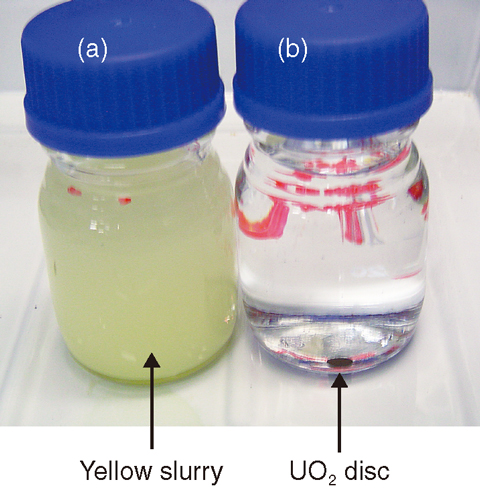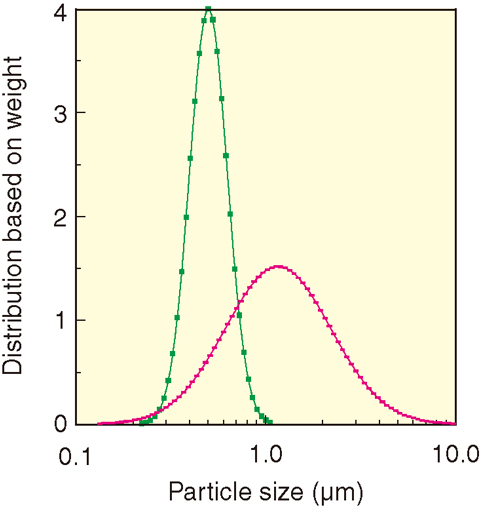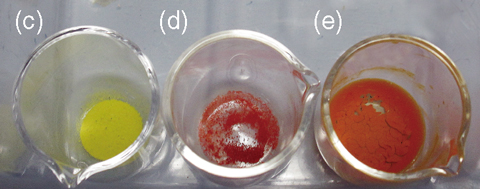
Fig.1-29 Yellow slurry of UO4·4H2O and a UO2 disc in water

Fig.1-30 Particle size distribution of UO4·4H2O
 particle size distribution of the UO4·4H2O given by the immersion of UO2 in 10wt% H2O2 aqueous solution (pH 5.6),
particle size distribution of the UO4·4H2O given by the immersion of UO2 in 10wt% H2O2 aqueous solution (pH 5.6),  the distribution after hydrochloric acid (HCl) has been added to the slurry (pH 2.8). As the acidity of the aqueous solution is stronger, the particles are flocculated; consequently, the particle size becomes larger. This property means that the slurry is mesocolloidal.
the distribution after hydrochloric acid (HCl) has been added to the slurry (pH 2.8). As the acidity of the aqueous solution is stronger, the particles are flocculated; consequently, the particle size becomes larger. This property means that the slurry is mesocolloidal.

Fig.1-31 Uranium trioxide hydrate
During the accident at the TEPCO’s Fukushima Daiichi NPS, the nuclear fuels melted together with the structural materials of the nuclear reactors and became debris. It is supposed that a portion of the debris may have dropped into the cooling water. In such a quenching condition, the debris could be pulverized into small particles. In addition, the particle size would become smaller by oxidation. Small powders of the debris will also be produced by cutting under the removal operations of the debris from the nuclear reactors. However, the chemical behaviors of the small particles of the debris in water are not understood.
Therefore, to investigate the chemical change and pulverization of debris immersed in cooling water for a long time, uranium dioxide (UO2), a component of the debris, was immersed in pure water as well as sodium chloride (NaCl), hydrogen peroxide (H2O2), and boric acid (H3BO3) aqueous solutions for a month at 50 ℃. As shown in Fig.1-29, UO2 reacted perfectly with H2O2; consequently, yellow particles of uranium peroxide tetrahydrate (UO4·4H2O) were formed. It was found that the average particle size was smaller than 1 μm, as shown in Fig.1-30, and that the slurry showed mesocolloidal properties. In contrast, UO2 did not show notable chemical changes in the other aqueous solutions.
The chemical bonding of the UO2 and H3BO3 was investigated by infrared spectroscopy. From the result, H3BO3 was predicted not to accompany the debris under removal operations from the H3BO3 aqueous solution. The influence of heating temperature and humidity on the hydration number of uranium peroxide hydrates was investigated. It was found that although UO4·4H2O changed to orange anhydrous uranium trioxide (UO3) under heating at 300 ℃, UO3 absorbed the moisture and easily suffered the hydration. Please see Fig.1-31.
This topic includes a part of the results of “Establishment of basic technology for decommissioning and safety of nuclear reactors for power generation” in FY 2013 that was entrusted to IRID from METI and of the subsidy program “Project of Decommissioning and Contaminated Water Management” in the FY 2013 supplementary budget and conducted by JAEA as a member of IRID.